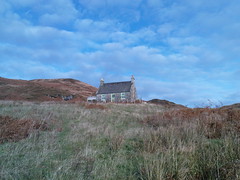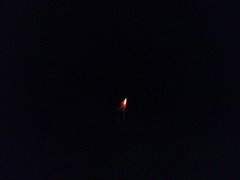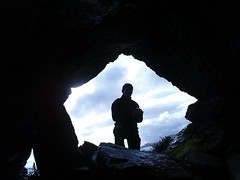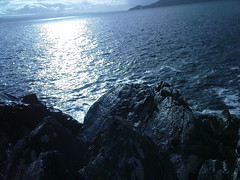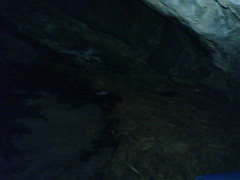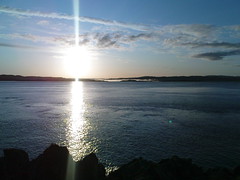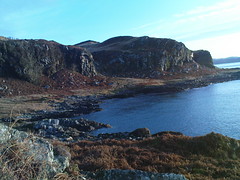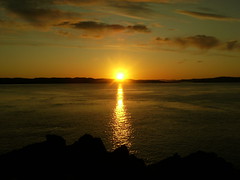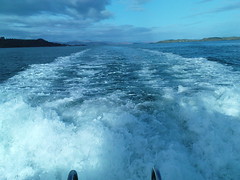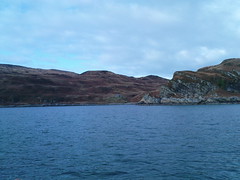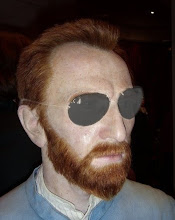This weekend just gone (Nov 5th), me and my fellow colleagues and friends went on a 4 day camping trip to Scarba; a diddy little island in Argyll and Bute. Here's a summary of the long weekend.
The total trip was from four days, Thursday to Sunday; but it lasted a little longer than that, I'll tell you why later.
I went with 4 others, 3 of which were from SCE and 1 was a friend of a SCEite.
The trip started as I got picked up by David, who very very kindly offered to drive me and Nick. The others were making their own way there. The drive time was about 9 hours and he did the whole lot, there and back, more or less in one go. Bravo to him. We hastily got all our things together, then we started the epic drive which took us through Birmingham, between Manchester and Liverpool, through Preston, Lancaster, Kendal, Carlisle then Glasgow. We stopped at one or two services for a break and a few supplies. The next part of the route took us through Argyll and a variety of beautiful Lochs through Inveraray. This was the time it got to be a real site, even though it was dark. It was great to see the lights of houses and cars reflected in the water. We even stopped a few times to take a look. I think we were also testing out the temperature :)
The dock where we were going to take the boat trip to Scarba was in a place called Ardfern. Which is a little village on the edge of the sea. We three took a look around Ardfern and decided to check out a place a local map said had a castle ruin. We didn't find too much of a ruin but we did find a dock or bridge of sorts and some old ruined buildings which did have an element of eeriness in the dark. We also found a fire still alight, where presumably some of the locals had lit a fire and shot some fireworks. We soon met up with the other two and decided to set-up camp for the night. Surprisingly this was the only time we used our tents.
In the morning we took the boat trip from the dock. The trip took about an hour and half apparently, but it seemed much shorter than that. We saw that the sea was quite active as there was a fairly strong wind, the boatmen said there was a gale warning as we neared the island. At this point the wind picked up. In fact they had some problems docking with the wind, a few of us had to get out and help secure the boat to the moorings after a few attempts at getting close to the rock. They advised we head for the bothy on the other side of the island. When we got our things off, that's exactly what we did.
The trip to the Bothy was, to be honest, long and hard with all of our supplies and kit. I for one struggled in the rain and the wind. This was of the more gruelling times we faced, and not the first time my fitness challenged me.
After some time, we made it to the Bothy, thanks to Rich's mostly faultless map reading skills. What we found when we got there surprised all of us. We all expected a bunch of stones loosely resembling a small house. What we found was a great little home on the top of a beach facing the sea. It had a bunch of rooms with tables and chairs, some supplies others had left, even some camp beds. It was in great condition. We started a fire and got settled in. We later cracked out a some fireworks and some sparklers :)
The next day we did some good exploring, following the rocky beach and cost around, finding some interesting geography, like caves, streams and pools. Lots of the caves showed fairly recent activity by other people, which I was a little surprised about. We also saw some great wildlife. Scarba has quite a large deer population and it was great to see them running around in herds, poking around on hills and steering clear of us as we potted around the coast. One of the coolest things to see was the various birds, particularly the birds of prey. We saw a few different birds, a few riding the currents staying motionless in the air looking for prey. The best by far for me was a pair of huge eagles, which I'm guessing were Golden Eagles or Sea Eagles. It was great to see these majestically swoop up past, along a small cliff-face next to us.
Next we made our way to the summit of Scarba, which I believe is around 450 metres high. Passing on the way a lake in the hills. Not all of us quite made it to the summit though. By the time we got near the summit it was getting dark, which was the disadvantages of going in the winter, with its short days. Although there is a fairly trodden path, it was made a bit more difficult to walk in the dark, especially as it was so wet and muddy.
That night we decided to stay in one of the caves we saw earlier, as it seemed perfect for it; and something to write home about. I was initially hesitant after the exhausting trek of the day, but after some food and a rest I was excited about the prospect. We collected all of the kit we needed and made a way around the coast from the Bothy. This was the route we took earlier in the daylight. Next to the cave was the perfect site for a fire. We got a great fire going and got stuck in to some of the beers and whisky we had. This was the highlight of the trip; nothing beats the warmth and atmosphere of a natural outdoor fire (alongside a touch of amazing whisky). The cave was actually very warm and we all slept fairly well and comfortably. Sleeping caves are something I highly recommend!
The next morning we woke early so we would catch the boat, sort our kit out and clean the bothy, so it would be as close as we could to the great condition we found it in. The sight of the sun over the water in the morning light was something to behold as I crawled out of the cave mouth. Unfortunately I missed the sun-rise, being one of the later of us to wake up.
That day we reached the dock for our boat trip home. We were there in plenty of time which was a relief. The boatmen soon told us that a fishing boat had called for assistance though. They gave us the choice of whether to go back to the dock in Ardfern (as we had hired their time for that) or help them and the boat in trouble by allowing them to reach them quicker. We couldn't refuse, partly to help the fishing boat and partly because of the adventure. The boatmen estimated 3 or 4 hours based on the fishing boatmen's description of their distance out at sea. This turned out to be a much longer and chillier affair. From jumping on the boat at around 12.15pm, we weren't in Ardfern until around 19.30pm, by then it was well into darkness. It wasn't all bad though, it was cool to see the fisherman's boat being tugged into the next village along the coast.
A few remarks on the trip:
I was surprised and pleased to see how well people had provided for others who would follow in their footsteps. We found useful things in the bothy, everything in good or reasonable condition, and plenty of fire wood.
The boatmen were great guys, they gave us a few coffees and chatted to us during the trip and the rescue.
It's best to go in the longer days where you have more daylight with which to do things.
Overall though, it was a great time, with lots of great sights and hijinks - and also a few challenges, but ones that made the trip all the more satisfying.

